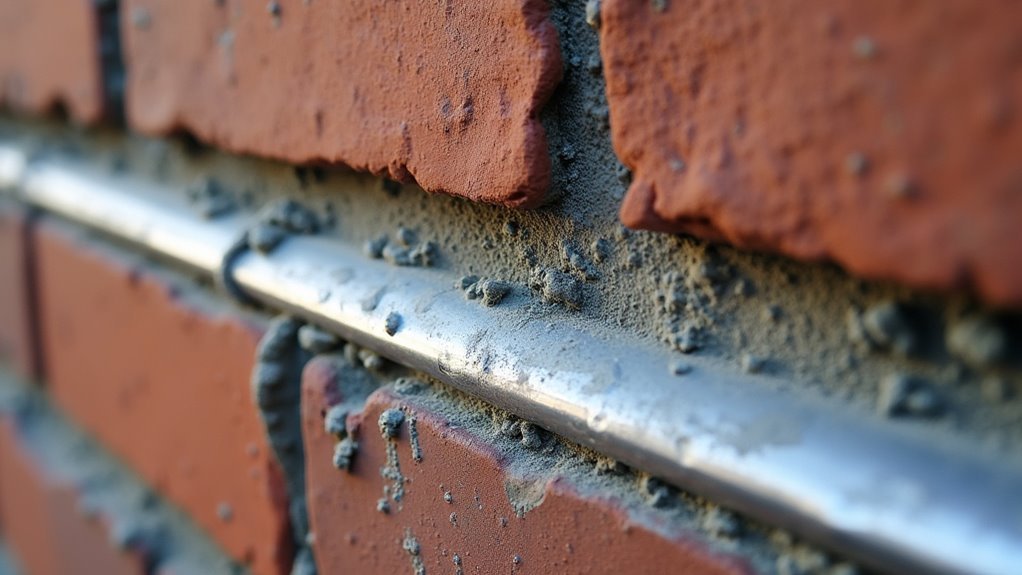You can effectively block mice from entering your home by installing metal flashing around your foundation’s vulnerable entry points. Focus on utility pipes, foundation vents, and electrical conduits where mice exploit gaps as small as ¼ inch. Use galvanized sheet metal or stainless steel flashing at least 24 inches wide to create an impenetrable barrier. This DIY solution costs approximately $60 in materials and provides long-term protection while eliminating expensive pest control services and preventing structural damage.
Why Metal Flashing Is Essential for Mouse Prevention

Mice can squeeze through gaps as small as ¼ inch, making your home’s foundation a prime entry point for these persistent rodents. You need metal flashing to create an effective barrier that mice can’t gnaw through, unlike wood or plastic materials they’ll easily destroy.
This durable solution seals critical entry points around your foundation and exterior walls where rodents typically gain access.
Metal flashing doesn’t just prevent rodents from entering your home—it also protects against water damage by directing moisture away from vulnerable areas. You’re investing in both pest control and structural integrity with one installation.
The hard metal surface creates an impenetrable barrier that stops mice from establishing pathways into your home, making it essential for thorough rodent prevention.
Common Foundation Entry Points Mice Exploit
Several critical areas around your foundation create perfect entry points that mice consistently exploit to access your home. You’ll find these rodents squeeze through openings as small as ¼ inch around utility pipes, electrical conduits, and foundation edges. Foundation vents with damaged screens become highways into crawl spaces, while gaps beneath porches and garage steps offer hidden access routes.
| Entry Point | Size Opening | Risk Level |
|---|---|---|
| Utility pipes | ¼ inch gaps | High |
| Foundation vents | Screen damage | High |
| Electrical conduits | Small cracks | Medium |
| Porch gaps | Variable | Medium |
| Garage steps | Foundation gaps | High |
Regular inspections help you identify vulnerable spots where metal flashing installation can prevent mice from entering. Installing metal flashing around these areas effectively blocks access and protects your living spaces.
Types of Metal Flashing Materials for Rodent Control

When selecting metal flashing for rodent control, you’ll find that galvanized sheet metal stands out as the most popular choice due to its exceptional durability and resistance to gnawing. Mice and rats can’t chew through this robust material, making it an effective barrier for sealing potential access points around your foundation.
Stainless steel flashing offers another excellent option, providing superior corrosion resistance and strength for long-lasting protection. While more expensive than galvanized options, it delivers exceptional durability in harsh weather conditions.
Choose flashing that’s at least 24 inches wide to adequately cover gaps and seams. Custom-bent pieces allow you to achieve a tailored fit around corners and irregular surfaces, ensuring complete coverage of vulnerable areas where rodents typically attempt entry.
Tools and Supplies Needed for Installation
You’ll need specific metal materials and installation tools to create an effective rodent barrier around your foundation.
The right supplies guarantee your flashing installation withstands both weather conditions and persistent mice attempting to gnaw through weaker materials.
Let’s examine the essential metal components and required tools that’ll make your installation successful and long-lasting.
Essential Metal Materials
Before installing metal foundation flashing to block mice, gather the right tools and materials to guarantee a professional-grade installation.
You’ll need galvanized sheet metal as your primary barrier material, offering durability and corrosion resistance against weather elements. Stainless steel screws provide secure attachment points that won’t rust over time, ensuring your rodent control system remains effective.
High-quality caulk is essential for sealing joints and edges, preventing moisture infiltration and eliminating tiny gaps mice exploit.
When you install metal flashing, use continuous pieces around corners to minimize potential entry points. This metal barrier approach creates an impenetrable foundation seal that effectively blocks rodent access while maintaining structural integrity and weather protection for years.
Required Installation Tools
A successful metal foundation flashing installation depends on having the right tools at your disposal. You’ll need a metal brake to create custom bends and shapes, ensuring your metal flashing achieves a secure fit around foundation entry points.
Essential supplies include galvanized sheet metal for long-lasting durability, caulking to seal edges effectively, and stainless steel screws for reliable attachment.
A tape measure is vital for accurately measuring gaps and determining flashing length requirements.
Don’t forget safety equipment—gloves and goggles protect you from sharp metal edges and debris during installation.
Finally, you’ll need a drill or screwdriver to fasten the flashing securely to foundation surfaces, creating an effective barrier to prevent rodent entry into your home.
Measuring and Cutting Custom Sheet Metal Pieces

Creating custom sheet metal pieces starts with precise measurements of the gaps between your foundation and siding where you’ll install the flashing. Measure both the length and height of each gap to guarantee accurate dimensions for a snug fit.
When cutting your galvanized sheet metal pieces, use tin snips or a metal saw to achieve clean, precise edges. Allow for slight overlap between pieces to enhance the seal and prevent gaps that could allow rodent entry.
Use a metal brake to bend the metal into the desired Z or L profile shape. Before installation, verify the area is clean and dry, as proper adhesion of caulk requires a clean surface for peak sealing against mice.
Step-by-Step Foundation Flashing Installation Process
With your custom metal pieces cut and shaped, you’re ready to begin the installation process that will permanently block mice from accessing your home’s foundation.
Start by loosening the screws on your siding where the flashing will be installed. Carefully slide each metal piece underneath the siding, ensuring it sits flush against the foundation. Secure the flashing tightly by retightening the screws, creating a continuous barrier that prevents rodent entry.
Make sure each piece overlaps at the joints to eliminate potential gaps. The flashing should extend beneath the siding sufficiently to block any entry points mice might exploit.
Inspect your work to confirm there’s no space between the metal and foundation surfaces.
Sealing Gaps Around Corners and Penetrations
Corners and penetrations represent the most challenging areas of your foundation flashing project, as these spots typically harbor the smallest gaps that mice exploit most frequently. You’ll need custom-bent galvanized sheet metal for sealing gaps around these vulnerable points. Focus on creating continuous barriers that fit tightly against all surfaces.
| Location | Gap Size Risk | Flashing Technique | Inspection Frequency |
|---|---|---|---|
| Inside corners | High | Overlap joints 2″ minimum | Monthly |
| Outside corners | Medium | Bend continuous piece | Quarterly |
| Pipe penetrations | Very High | Cut precise collar fit | Monthly |
| Electrical entries | High | Seal around conduit completely | Bi-monthly |
Ensure your flashing doesn’t extend beyond side wall ribs. When rodents can’t gain access through these sealed areas, you’ll effectively solve your rodent problem through proper metal barrier installation.
Maintenance and Inspection of Metal Barriers
Even the most expertly installed metal flashing requires ongoing attention to maintain its effectiveness against rodent intrusion.
You’ll need to inspect your metal barriers at least twice yearly, focusing on areas around foundations, doors, and vents where flashing is most critical. During maintenance checks, look for signs of wear, corrosion, or damage that could compromise the barrier’s integrity.
Ensure the flashing remains securely fastened without gaps or openings where mice could squeeze through.
Clean away debris and vegetation that accumulates around the flashing, as this provides cover for rodents attempting entry. When you discover damaged sections, repair or replace them immediately to maintain your rodent-proofing efforts.
Regular maintenance prevents small issues from becoming major vulnerabilities.
Cost-Effective Benefits of DIY Metal Flashing
When you consider the financial impact of rodent damage versus prevention costs, DIY metal flashing emerges as an exceptionally smart investment.
You’ll spend approximately $60 on materials to create a thorough barrier system that’ll prevent rodent entry for years to come. This cost-effective solution requires only basic tools and minimal skills, eliminating expensive contractor fees.
Custom-bent galvanized sheet metal seals gaps between your siding and foundation more effectively than temporary fixes.
You’ll save hundreds on future pest control services while protecting your property from costly structural damage. Since rodents can’t chew through metal like they do with other materials, you’re investing in ongoing protection that pays for itself.
This durable barrier transforms a small upfront expense into long-term savings.
Frequently Asked Questions
Can Mice Chew Through Metal Flashing?
No, you can’t expect mice to chew through metal flashing. Their teeth aren’t strong enough to penetrate galvanized steel. You’ll find metal creates an effective barrier that mice can’t grip or gnaw through successfully.
Will Flashing Lights Keep Mice Away?
Flashing lights won’t effectively keep mice away from your home. You’re better off sealing entry points and removing food sources since mice rely more on smell and hearing than vision for navigation.
How Do You Mouse Proof a Metal Building?
You’ll need to seal entry points with stainless steel wool around pipes and conduits. Repair damaged siding at corners and seams, then install custom-bent galvanized flashing around the building’s base for thorough protection.
How Do You Seal a House Foundation From Mice?
You’ll seal your house foundation by installing galvanized metal flashing around exterior walls, filling gaps with steel wool, and caulking openings around pipes and utilities to block mouse entry points.
In Summary
You’ve now equipped your home with a professional-grade mouse defense system using metal flashing. Your foundation’s vulnerable entry points are sealed, and you’ll save money on pest control services while protecting your property long-term. Remember to inspect your flashing annually for damage or gaps, and don’t forget to check around new installations or home modifications. You’re in control of keeping mice out permanently with this durable, cost-effective solution.





Leave a Reply